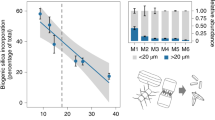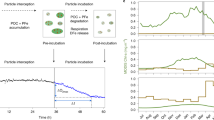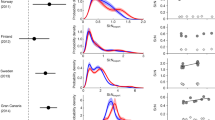Abstract
In large swaths of the ocean, primary production by diatoms may be limited by the availability of silica, which in turn limits the biological uptake of carbon dioxide. The burial of biogenic silica in the form of opal is the main sink of marine silicon. Opal burial occurs in equal parts in iron-limited open-ocean provinces and upwelling margins, especially the eastern Pacific upwelling zone. However, it is unclear why opal burial is so efficient in this margin. Here we measure fluxes of biogenic material, concentrations of diatom-bound iron and silicon isotope ratios using sediment traps and a sediment core from the Gulf of California upwelling margin. In the sediment trap material, we find that periods of intense upwelling are associated with transient iron limitation that results in a high export of silica relative to organic carbon. A similar correlation between enhanced silica burial and iron limitation is evident in the sediment core, which spans the past 26,000 years. A global compilation also indicates that hotspots of silicon burial in the ocean are all characterized by high silica to organic carbon export ratios, a diagnostic trait for diatoms growing under iron stress. We therefore propose that prevailing conditions of silica limitation in the ocean are largely caused by iron deficiency imposing an indirect constraint on oceanic carbon uptake.
This is a preview of subscription content, access via your institution
Access options
Subscribe to this journal
Receive 12 print issues and online access
$259.00 per year
only $21.58 per issue
Buy this article
- Purchase on Springer Link
- Instant access to full article PDF
Prices may be subject to local taxes which are calculated during checkout



Similar content being viewed by others
References
Nelson, D. M., Treguer, P., Brzezinski, M. A., Leynaert, A. & Queguiner, B. Production and dissolution of biogenic silica in the ocean—revised global estimates, comparison with regional data and relationship to biogenic sedimentation. Glob. Biogeochem. Cycles 9, 359–372 (1995).
Ragueneau, O. et al. A review of the Si cycle in the modem ocean: Recent progress and missing gaps in the application of biogenic opal as a paleoproductivity proxy. Glob. Planet. Change 26, 317–365 (2000).
Archer, D. & Maier-reimer, E. Effect of deep-sea sedimentary calcite preservation on atmospheric CO2 concentration. Nature 367, 260–263 (1994).
Brzezinski, M. A. The Si–C–N ratio of marine diatoms-interspecific variability and the effect of some environmental variables. J. Phycol. 21, 347–357 (1985).
Sarmiento, J. L., Gruber, N., Brzezinski, M. A. & Dunne, J. P. High-latitude controls of thermocline nutrients and low latitude biological productivity. Nature 427, 56–60 (2004).
Moore, J. K., Doney, S. C. & Lindsay, K. Upper ocean ecosystem dynamics and iron cycling in a global three-dimensional model. Glob. Biogeochem. Cycles 18, GB4028 (2004).
Dugdale, R. C., Wilkerson, F. P. & Minas, H. J. The role of a silicate pump in driving new production. Deep-Sea Res. I 42, 697–719 (1995).
Dugdale, R. C. & Wilkerson, F. P. Silicate regulation of new production in the equatorial Pacific upwelling. Nature 391, 270–273 (1998).
Tréguer, P. et al. The silica balance in the world ocean: A reestimate. Science 268, 375–379 (1995).
Broecker, W. S. & Peng, T. H. Tracers in the Sea (Eldigio Press, 1984).
Tréguer, P. & De La Rocha, C. The world ocean silica cycle. Ann. Rev. Mar. Sci. 5, 477–501 (2013).
Sirocko, F. Deep-sea sediments of the arabian sea—a paleoclimatic record of the southwest-asian summer monsoon. Geol. Rundsch. 80, 557–566 (1991).
Demaster, D. J. The supply and accumulation of silica in the marine-environment. Geochim. Cosmochim. Acta 45, 1715–1732 (1981).
Thunell, R. C. Seasonal and annual variability in particle fluxes in the Gulf of California: A response to climate forcing. Deep-Sea Res. I 45, 2059–2083 (1998).
Honjo, S., Steven, J. M., Richard, A. K. & Roger, F. Particulate organic carbon fluxes to the ocean interior and factors controlling the biological pump: A synthesis of global sediment trap programs since 1983. Prog. Oceanogr. 76, 217–285 (2008).
Jickells, T. D. et al. Global iron connections between desert dust, ocean biogeochemistry, and climate. Science 308, 67–71 (2005).
Brand, L. E. Minimum iron requirements of marine-phytoplankton and the implications for the biogeochemical control of new production. Limnol. Oceanogr. 36, 1756–1771 (1991).
Martin, J. H. et al. Testing the iron hypothesis in ecosystems of the equatorial Pacific Ocean. Nature 371, 123–129 (1994).
Falkowski, P. G. Evolution of the nitrogen cycle and its influence on the biological sequestration of CO2 in the ocean. Nature 387, 272–275 (1997).
Takeda, S. Influence of iron availability on nutrient consumption ratio of diatoms in oceanic waters. Nature 393, 774–777 (1998).
Brzezinski, M. A. et al. A switch from Si(OH)(4) to NO3-depletion in the glacial Southern Ocean. Geophys. Res. Lett. 29, 1564 (2002).
Hutchins, D. A. & Bruland, K. W. Iron-limited diatom growth and Si:N uptake ratios in a coastal upwelling regime. Nature 393, 561–564 (1998).
Firme, G. F., Rue, E. L., Weeks, D. A., Bruland, K. W. & Hutchins, D. A. Spatial and temporal variability in phytoplankton iron limitation along the California coast and consequences for Si, N, and C biogeochemistry. Glob. Biogeochem. Cycles 17, 1016 (2003).
Fitzwater, S. E. et al. Iron, nutrient and phytoplankton biomass relationships in upwelled waters of the California coastal system. Cont. Shelf Res. 23, 1523–1544 (2003).
Chase, Z. et al. Manganese and iron distributions off central California influenced by upwelling and shelf width. Mar. Chem. 95, 235–254 (2005).
Calvert, S. E. Accumulation of diatomaceous silica in the sediments of Gulf of California. Geol. Soc. Am. Bull. 77, 569–596 (1966).
Pichevin, L. et al. Silicic acid biogeochemistry in the Gulf of California: Insights from sedimentary Si isotopes. Paleoceanography 27, PA2201 (2012).
Segovia-Zavala, J. A., Lares, M. L., Delgadillo-Hinojosa, F., Tovar-Sanchez, A. & Sanudo-Wilhelmy, S. A. Dissolved iron distributions in the central region of the Gulf of California, Mexico. Deep-Sea Res. I 57, 53–64 (2010).
Twining, B. S. et al. Metal quotas of plankton in the equatorial Pacific Ocean. Deep-Sea Res. II 58, 325–341 (2011).
Arellano-Torres, E., Pichevin, L. E. & Ganeshram, R. S. High-resolution opal records from the eastern tropical Pacific provide evidence for silicic acid leakage from HNLC regions during glacial periods. Quat. Sci. Rev. 30, 1112–1121 (2011).
De la Rocha, C. L., Brzezinski, M. A. & DeNiro, M. J. A first look at the distribution of the stable isotopes of silicon in natural waters. Geochim. Cosmochim. Acta 64, 2467–2477 (2000).
Reynolds, B. C., Frank, M. & Halliday, A. N. Silicon isotope fractionation during nutrient utilization in the North Pacific. Earth Planet. Sci. Lett. 244, 431–443 (2006).
Franck, V. M., Brzezinski, M. A., Coale, K. H. & Nelson, D. M. Iron and silicic acid concentrations regulate Si uptake north and south of the Polar Frontal Zone in the Pacific Sector of the Southern Ocean. Deep-Sea Res. II 47, 3315–3338 (2000).
Georg, R. B., Reynolds, B. C., Frank, M. & Halliday, A. N. New sample preparation techniques for the determination of Si isotopic compositions using MC-ICPMS. Chem. Geol. 235, 95–104 (2006).
Reynolds, B. C., Georg, R. B., Oberli, F., Wiechert, U. H. & Halliday, A. N. Re-assessment of silicon isotope reference materials using high-resolution multi-collector ICP-MS. J. Anal. At. Spectrom. 21, 266–269 (2006).
Morley, D. W. et al. Cleaning of lake sediment samples for diatom oxygen isotope analysis. J. Paleolimnol. 31, 391–401 (2004).
Ellwood, M. J. & Hunter, K. A. Determination of the Zn/Si ratio in diatom opal: A method for the separation, cleaning and dissolution of diatoms. Mar. Chem. 66, 149–160 (1999).
Acknowledgements
We thank S. Calvert, K. Darling and B. Reynolds for discussions. Financial support for this project was provided by the Scottish Alliance for Geoscience Environment Society (SAGES), and the Natural Environment Research Council (NERC) through a Standard NERC grant to R.S.G. and L.E.P. Sediment Core MD 02-2515 was retrieved during the MONA (Marges Ouest Nord Américaines) cruise of the RV Marion Dufresne (International Marine Global Changes-IMAGES VIII) in June 2002.
Author information
Authors and Affiliations
Contributions
L.E.P. and R.S.G. initiated the project. L.E.P. and R.H. measured diatom-bound trace metals, L.E.P. measured elemental composition and silicon isotopes, W.G. and R.T. provided samples for diatom-bound trace metal measurements, and L.E.P. and R.S.G. wrote the paper with the participation of W.G. All authors were involved in the discussions of the results and commented on the manuscript.
Corresponding author
Ethics declarations
Competing interests
The authors declare no competing financial interests.
Supplementary information
Supplementary Information
Supplementary Information (PDF 3369 kb)
Rights and permissions
About this article
Cite this article
Pichevin, L., Ganeshram, R., Geibert, W. et al. Silica burial enhanced by iron limitation in oceanic upwelling margins. Nature Geosci 7, 541–546 (2014). https://doi.org/10.1038/ngeo2181
Received:
Accepted:
Published:
Issue Date:
DOI: https://doi.org/10.1038/ngeo2181
This article is cited by
-
Diminished carbon and nitrate assimilation drive changes in diatom elemental stoichiometry independent of silicification in an iron-limited assemblage
ISME Communications (2022)
-
Impaired viral infection and reduced mortality of diatoms in iron-limited oceanic regions
Nature Geoscience (2021)
-
Reverse weathering as a long-term stabilizer of marine pH and planetary climate
Nature (2018)



